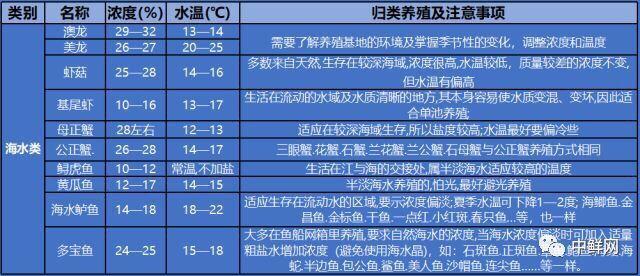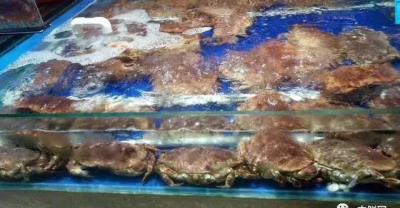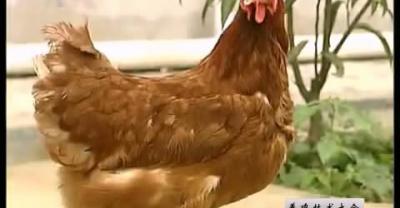With "fresh taste" aquaculture and fresh dry goods express!
Operation and Management of Aquatic products-- breeding & fresh-keeping
▼

Fresh training video, please follow the official Wechat fresh class on Zhongxian.com.
▼
Aquatic products are the embodiment of the highest level of supermarket management, and there are many difficulties in operation, such as breeding, preservation, maintenance and management of commodities. And most of the aquatic commodities are classified: live fish, marine fish, live crabs and shellfish. How to break through the difficulties of aquatic products management? You might as well take a look at the current situation of aquatic products management:
▶ 'Analysis of the present situation of Aquatic products'
▼
Analysis on the present situation of Aquatic products

The culture technology of ☑ live aquatic fish, seafood and shellfish needs to be improved.
The main commodity of ☑ is not obviously reflected.
☑ lacks equipment maintenance and commodity maintenance management.
The aesthetic feeling of ☑ display is insufficient, and the commodity atmosphere is not good.

☑ loose frozen products are disorderly displayed.
The lack of timely finishing of ☑ goods leads to serious frost accumulation in frozen goods.
Goods that affect the quality of sale appear in ☑ layout.
☑ items are seriously missing.
▶ 'aquaculture'
▼
Aquaculture and fresh-keeping of commodities
☑ marine fish and freshwater fish are cultured separately, and the water quality requirements are different.
☑ high-grade seafood and ordinary seafood are cultured separately.
☑ scaly fish and scaleless fish are cultured separately, and tropical fish are cultured separately.
The water temperature and salinity of fish cultured together in ☑ should be as similar as possible. For example, Boston lobster and turbot fish can be raised together. The salinity of Boston lobster is between 25 and 26 degrees, and turbot fish is basically adapted to 18 to 19 degrees, but it is also possible to put them in an environment of 25 degrees.
☑ new and used goods separate culture, it is best to first-in, first-out, freshwater fish management is mainly to improve commodity turnover.
Temperature and salinity of seafood culture

For rational aquaculture, to understand the living habits of commodities, grasp seasonal changes, adjust concentration and temperature, it is recommended to make a table and record it at intervals of two hours a day. Records include water quality, water temperature, salinity, commodity status and equipment operation. Soon, we will be able to find out the culture conditions of most seafood commodities, and we can deal with them in time and make predictions in advance.
Salinity and temperature of conventional items

Basic requirements of live and fresh culture
Fresh commodities are alive, and there are certain requirements for the living environment (water quality, water temperature, salinity), so it is necessary to create a culture environment similar to the original living environment of fresh commodities to prolong their life. In the process of culture, we should pay close attention to the situation of commodities and culture environment:
☑ can see.
▫ observes the color of water quality to judge the cleanliness of water.
▫ observes the appearance of the fish, the strength of swimming and the brightness of the eyes to judge the fresh state of the fish.
☑ is on hand.
▫ touches the fish with his hand to judge the state of the fish.
▫ touches the pool water with his hand to determine whether the water temperature meets the requirements (manual perception is different, but as a daily rough inspection, there should be a measuring tool.)
☑ nose to
Smell the smell of water to judge the degree of water pollution
Problems and Countermeasures in Night Culture work
Night aquaculture is a key and difficult operation period in aquatic product management. Due to the strong independence of work, the difficulty of working at night and other factors, it will lead to the following situations, which can not be found and solved in time, resulting in the loss of commodities:
▫ equipment suddenly tripped or burnt out.
▫ oxygen tube loosens and falls off
▫ aquaculture pond leakage
▫ water temperature anomaly
▫ fish jump to the ground
Countermeasures: it is suggested that the night duty personnel should be trained as aquaculture personnel to enhance their sense of responsibility. Carry on the careful itinerant inspection to the operation condition of the equipment, the change of water temperature, the activity of fish and the fresh-keeping goods, and deal with the situation in time. For example, when you find a large area of fish tumbling at night, you should first throw salt or seawater crystals into the water, then hit the water with ice, try to activate it, and add oxygen. Finally, you can replace part of the water and lower the water temperature.
The preparation work before coming to the fish and the inspection after launching the fish
The breeding vehicle must be disinfected comprehensively before coming to the fish. after water storage, the water temperature should be adjusted and the water quality should be disinfected. The fish should be closely observed and examined after entering the fish. Otherwise, the following occurs:
▫ fish lack oxygen due to high density.
The water quality of ▫ becomes dirty and seriously polluted or produces serious foam to cover the pond, resulting in fish asphyxiation.
▫ dead fish can not be disposed of in time
Countermeasures:
When ① came to fish, the activity difference was reported in time, and the activity of fish was excited by appropriate amount of seawater crystals, and whether the circulating water was working normally was checked at the same time. The water of freshwater fish is replaced by 1 beat 3 fresh water every day, and replaced with 1 tap 3 new water. The water of marine fish should not be changed frequently, and the sundries should be cleared out by fishing every day. The sponge of the filter net is recommended to be washed every morning, middle and evening.
When the density of ② fish is high, divide the pond in time.
When the ③ water quality becomes dirty, change the water in time, and pay attention to the change of water temperature and fish activity.
④ keeps dead fish fresh in time to reduce the value (value).
Problems needing attention in aquaculture work and countermeasures
Problems that are prone to occur:
▫ forgot to turn off the equipment and began to clean the fish pond. The water pump will burn down in circulation.
After ▫ cleaning, the water is still dirty, and dirt and moss appear in the water.
After ▫ washing the pond, put the fish back into position without checking the water temperature or salinity. after cleaning and disinfecting and changing the water, keep the water for 6-8 hours.
Countermeasures:
① works strictly according to the steps
② does not leave a dead corner (including filter pool wall, storage tank, bottom pool wall and pump leakage net, etc.)
After ③ cleaning, the water temperature should be adjusted and effective disinfection should be carried out before the fish return to position or only when changing water.
Key points of culture
Water quality: ensure that the water quality in the culture pond is clean, change the water in time, and disinfect the fish pond.
Temperature: continuously adjusted according to commodity characteristics and seasons to achieve suitability
Density: according to the actual size of the store fish pond, reasonably adjust the density of fish to avoid excessive culture, resulting in hypoxia.
Oxygen content: reasonably adjust the oxygen in the culture pond to avoid the death of fish caused by too much or too little oxygen.
Salinity: understand the living environment and characteristics of goods, and constantly adjust to achieve suitability.
▶ 'commodity fresh-keeping'
The preservation of fresh products-- the method of keeping fresh with ice salt water
☑ prepares goods that need to be kept fresh
☑ add coarse salt and stir evenly:
Concentration: 7% (e.g. 20 jin of ice water + 1.5 jin of salt)
☑ add water and ice, stir well:
Temperature: 3-5 ℃ (50% ice water)
☑ thoroughly soaked the goods in ice-salt water.
☑ is then covered with dry ice and flattened by hand
☑ is stored in a cool and ventilated place
Suitable commodities for salt water preservation: Changyu, squid, flatfish, Meichang, Tetranychus, octopus, mackerel
The preservation of fresh products-- the method of keeping fresh with dry ice
☑ prepares goods that need to be kept fresh
There are four small holes in the bottom of the ☑ foam box.
☑ lays a layer of 5cm dry ice on the bottom of the foam box.
☑ displays goods (fish belly needs to be symmetrical) to achieve one layer of ice and one layer of goods.
☑ is finally covered with 15cm's dry ice and paved.
☑ is stored in a cool and ventilated place
Operation points: goods such as big yellow croaker, half-side fish and goldfish must be separated from ice when keeping fresh.
Applicable commodities: all chilled products except Shuifa, Changyu, Meichang, mackerel and so on.
Fresh keeping in the process of selling chilled food
☑ spray ice water: spray ice water evenly on the goods to keep them fresh.

Applicable commodities: except watery hair, packaging and goods that are easy to change color in the presence of water (such as boss fish, grouper belly, yellow croaker).
☑ spread dry ice: put a thin layer of dry ice on the goods to "cover your belly and reveal your gills".
Applicable commodities: goods that are easy to change color (such as boss fish, fresh belt fish, grouper belly, yellow croaker) should be avoided, other commodities are applicable.
☑ ice salt water preservation: soak the goods in ice salt water for 1-2 minutes and then sell them on the table to restore the freshness of the goods.
Applicable commodities: goods that are easy to change color (such as boss fish, grouper belly, yellow croaker) should be avoided, other commodities are applicable.
Storage and fresh-keeping of shellfish and clam
☑ operation steps
Fasten the mouth of the bag, fasten it and put it into the warehouse, cover with cloth. After fastening the mouth of the bag, put it into the fresh-keeping warehouse and cover it with cloth, and store the goods on the pallet.
Applicable commodities: clam, snail, Sinonovacula, oil clam
Considerations for ☑
When there is a lot of surplus oysters, you can add ice after pouring out the ice water.
Meretrix Meretrix Linnaeus needs to dissipate heat in summer before entering the warehouse.
Ding snail, ice bag is needed in summer
Water quality table of main shellfish culture
Method of cold storage for commodity recovery
Maintenance process of chilled fish cold storage
☑ uses turnover boxes or foam boxes to fill holes in the top, bottom, left and right positions of the bottom.
☑ put the piece of ice evenly into the bottom of the box, and the thickness of the ice layer is appropriate.
☑ fish conservation must use white (colorless) plastic film to isolate borneol (avoid ice water touching the fish directly)
☑ puts the chilled fish (in the case of yellow croaker) up in the belly and arranges them tightly in order.
☑ is isolated with white plastic film and slices of ice 8-10cm.
☑ with foam box cover closed, fill in the warehouse shelf life card according to the goods and affix it to the lower right of the foam box.
Note: this fresh-keeping method can be applied to all scale fish. Chilled barbecue and Pomfret should be sealed with ice salt water in fresh boxes or iron boxes.
- Prev

Blue Snowflake breeding methods and precautions
Last year for the first time planted blue snowflake, achieved a small success, should flower friends request to share experience with you, the following is my summary of the breeding method of blue snowflake,...
- Next

How to maximize the profit of laying hens?
Engaged in laying hen farming, whether large companies or retail investors, everyone's ultimate goal is the same, that is profit. But the final profit varies greatly, which is.
Related
- On the eggshell is a badge full of pride. British Poultry Egg Market and Consumer observation
- British study: 72% of Britons are willing to buy native eggs raised by insects
- Guidelines for friendly egg production revised the increase of space in chicken sheds can not be forced to change feathers and lay eggs.
- Risk of delay in customs clearance Australia suspends lobster exports to China
- Pig semen-the Vector of virus Transmission (4)
- Pig semen-the Vector of virus Transmission (3)
- Five common causes of difficult control of classical swine fever in clinic and their countermeasures
- Foot-and-mouth disease is the most effective way to prevent it!
- PED is the number one killer of piglets and has to be guarded against in autumn and winter.
- What is "yellow fat pig"? Have you ever heard the pig collector talk about "yellow fat pig"?

